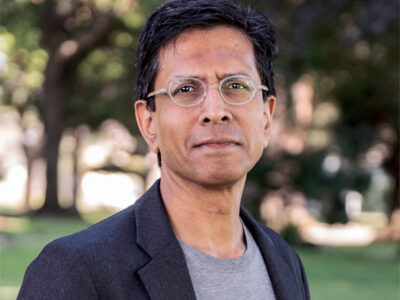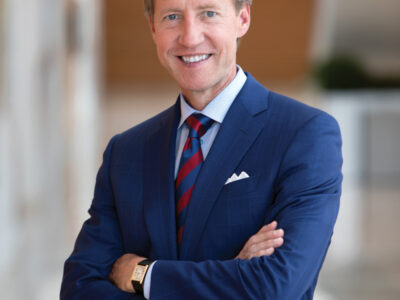
It’s mid March—a few weeks before he will step down from his position as Penn’s senior vice president for facilities and real estate services—and Omar Blaik is fighting a bug, but still planning to fly to Dallas in a few hours to meet with a contractor for a retail and residential development slated for 39th and Walnut streets. He’s been trying to extricate himself from the department’s decisionmaking process—Tom Stump, senior associate dean for the School of Engineering and Applied Science, has been named interim VP—but this trip is an exception, he says, not altogether convincingly.
When his resignation was announced in February, Penn President Amy Gutmann lauded Blaik’s nine years of service: “Under his talented leadership, Penn has taken enormous strides in transforming the campus and the University City community into a more lively and livable environment for faculty, students, visitors, and residents alike.”
Among the $2 billion in construction and real-estate projects he has overseen were the renovations to the Quad dormitories; the construction of Perelman Quad, Levine Hall, and the Penn Alexander School; the FreshGrocer, Bridge Cinema, and Marathon Grill and other developments at 40th Street; and the Left Bank, World Café Live, and Translational Research Labs at the eastern edge of campus.
Blaik describes his decision to leave Penn to start his own firm as “opportunity driven,” explaining that the role of universities in urban development is “very much in vogue” now, and Penn is seen as the model—“The place where we have done it, and done it right.” The other factor was a desire to stay put—in Philadelphia, if not at the University—for his “next career,” he says.
He began to consider striking out on his own last summer, and came to a decision over the winter holidays after consulting with some advisers outside Penn as to whether there really was a market for a venture like the one he had in mind, in which he would be doing essentially the same things as at Penn, but in the private sector. What he hopes to do is forge relationships with a handful of institutions that have a serious need and commitment to engage with the surrounding community. Based on that commitment, Blaik’s firm would purchase building sites around the institutions and “embark on an execution plan,” partnering with a developer. He expects that he will need to provide capital, rather than simply acting as a consultant, because most institutions would not have the willingness—or ability—to “take risks and create a capacity that didn’t exist previously,” as Penn did in the early stages of its revitalization in the 1990s.
Blaik came to Penn in 1997 as associate vice president for facilities, and a year later was promoted to vice president. His first assignment was to manage the University’s ill-fated outsourcing arrangement with Trammell Crow. Blaik allows that he might have moved a little more gradually, if it had been his decision, but generally defends the impulse behind outsourcing. Real estate at the University was not thought of as a business, he contends, or even as a strategic tool to implement a vision of the campus. While there was some obvious disruption involved in the outsourcing—and the ensuing “insourcing” when the agreement was dissolved in 2002—the department was “energized and professionalized” by the addition of new blood and new ideas from industry, he says, expressing pride in this “bright side” to the experience.
While Penn has become a model of urban redevelopment, success was far from a foregone conclusion. There were no takers among private developers for the project known as Sansom Common, encompassing the Inn at Penn, Penn Bookstore, and other retail and restaurants; the University had to put up the capital for construction itself—to the tune of about $150 million, Blaik estimates. A bit later, Penn was left holding the bag for an additional $15 million—on top of its planned investment of that amount—when its first partner in the movie theater at 40th Street, Robert Redford’s Sundance Cinema, dropped out of the project.
With the site lying idle, Blaik argued that the University should put up the second $15 million as well to complete construction, which “required a bit of chutzpah,” he says, as there was no economic model he could come up with that did not involve losing money on the deal. Ultimately, he offered an analogy to the anchor tenant in a mall, in which returns come from the retail around it.
Later, as the West Philadelphia neighborhood perked up and real estate values generally rose, private developers were more eager to get involved. For more recent projects like the Left Bank and WXPN/World Café Live on the eastern edge of campus, and ongoing developments on Chestnut at 40th and 34th streets, the University has provided developers with long-term ground leases, sharing in the income and eventually getting the properties back. Several decades down the road, Blaik notes, the University stands to come in for a windfall of prime real estate that will revert to its possession.
With the Bridge Cinema (opened in 2002 with a new partner), Marathon Grill, and the FreshGrocer supermarket across Walnut, 40th Street has been transformed; and the restaurants running along the corridor are varied and thriving, justifying Blaik’s mall analogy. But the new development there isn’t all about retail, he is quick to note.
Making use of some “nonperforming assets” that the University had purchased in the late 1980s and early 1990s, Blaik’s department has been involved in several initiatives that have “confused the boundaries” between the institution and the community by helping support small businesses and arts organizations. As examples, he mentions the Rotunda [“Gazetteer,” Nov/Dec 2005], which hosts a wide range of events with a great deal of community involvement, and the avant garde art gallery and performance space, the Slought Foundation [“All Things Ornamental,” Nov/Dec 2004] which, he says, “has put West Philadelphia on the map in the international-arts community.” Another program awards six months of free studio space through a competition for neighborhood artists.
Blaik’s office has also brokered relationships with the annual Philadelphia Film Festival in April and the Fringe Festival in September to use facilities in the area, which together brought an estimated 75,000 visitors—many of them first-timers—to West Philadelphia. All of this, he says, feeds into the idea of having the neighborhood be active, a destination, which is good for business and safety, and also provides students and residents with vibrant cultural options. Penn’s cinema-studies program [“Now Playing on the Big Screen,” Jan/Feb 2005] has integrated into the film festival, says Blaik, and also uses the Bridge for its own screenings.
While the issues may change—ironically, rising housing prices as the neighborhood has become more attractive have created concerns about affordability—community engagement must remain part of the University’s core mission, Blaik says. “We had to pay millions to bring it back” after previous decades of neglect. The relationship will never be “completely serene,” he adds, “given the University’s size and the resulting occasional institutional clumsiness,” but being involved in the neighborhood as individuals can help “humanize” Penn’s presence.
Blaik himself will continue to live, as he has for the past several years, in West Philadelphia with his wife and two children, who attend the Penn Alexander School. While he’d like to claim he chose the location to benefit Penn, he says, “I’m doing nobody a favor” by living in University City. He calls it the best neighborhood in the city for its combination of density and green space, its housing stock, and its people.
Blaik also played a significant role in shepherding the deal by which Penn is completing its long-desired acquisition of the old U.S. Post Office lands bordering the Schuylkill River.
As planning progresses to determine how the space will be used in the years to come, he counsels his successors to go slow, suggesting a frame of reference of 50 to 100 years from now. This is Penn’s only opportunity for expansion and growth, and it’s not at all clear what universities will need even 15 years out, so planners should avoid taking options away from later generations.
“Time is on our side,” he says.
—J.P.




